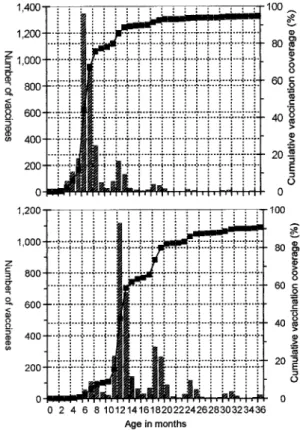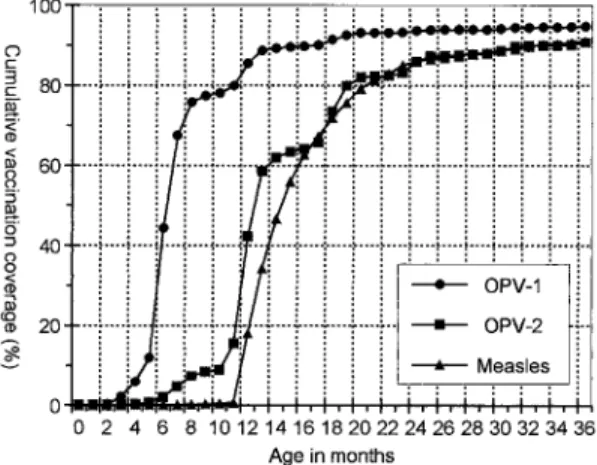序 文
ワクチン接種により当該疾患の流行を阻止する ためには,ワクチン接種率を高率に維持する必要 があることは広く知られているが,これまで予防 接種率の定義が明確になっていなかったため,ワ クチン接種状況を正確に把握することも,ワクチ ン接種勧奨の効果を経年的に比較検討することも 容易ではなかった.我々は,崎山が提唱した年齢 別ワクチン累積接種率(以下累積接種率)
1)が麻疹 ワクチン接種率調査に有用であると考え
2),本法 により日本全国の麻疹ワクチン接種率を算定・評
価することを計画した.2002 年に日本全国から 5,000 人の 3 歳児を無作為抽出して調査標本とし,
この標本における麻疹ワクチン接種月齢を各市区 町村の協力を得て調査し,月齢ごとの麻疹ワクチ ン累積接種率を求めた.この調査によって日本に おける麻疹ワクチン累積接種率は生後 18 カ月で 61.7±1.6%,24 カ月で 79.6±1.3%,生後 36 カ月で 86.9±1.1% であることが判明した
3).2003 年は同 じ調査を繰り返して麻疹ワクチン累積接種率に変 化がみられるか否かを検討した.一方,ポリオ生 ワクチン(OPV)は日本で最も安全で効果的なワ クチンとして信頼され,高い接種率を保持してい ると考えられている.しかし,実際の OPV 投与 は,ほとんどの市区町村では,春と秋に集団で行
麻疹ワクチン及びポリオ生ワクチン累積接種率全国調査結果
1)東京都立駒込病院小児科,2)崎山小児科,
3)国立感染症研究所ウイルス 2 部,4)聖マリアンナ医科大学小児科
! 山 直秀1) 崎山 弘
2) 宮村 達男
3) 加藤 達夫
4)
(平成 16 年 9 月 24 日受付)
(平成 16 年 11 月 5 日受理)
我々は 2002 年に,日本全国から 5,000 人の 3 歳児を無作為抽出して調査標本とし,この標本における 麻疹ワクチン接種月齢を調査して,月齢ごとの麻疹ワクチン累積接種率を求めた.この調査によって日 本における麻疹ワクチン累積接種率は生後 18 カ月で 61.7±1.6%,24 カ月で 79.6±1.3%,生後 36 カ月で 86.9±1.1% であることが判明した.2003 年に調査した麻疹ワクチン累積接種率を 2002 年の結果と比較 すると,2003 年に満 3 歳に達した小児群では 2002 年に満 3 歳になった小児群に比べて全体的に累積接 種率が改善しており,特に 1 歳代での改善が目立った.これは麻疹ワクチン接種担当者など予防接種関 係者が長年にわたり,麻疹ワクチン接種率の向上のために努力した結果と考えられる.2003 年には全国 麻疹ワクチン累積接種率調査とともに全国ポリオ生ワクチン(OPV)累積接種率をはじめて調査した.
OPV 1 回目の累積接種率は,生後 6 カ月で 44.2±1.5%,12 カ月で 85.5±1.1%,36 カ月で 94.7±0.8% で あった.OPV 2 回目の累積接種率は,生後 12 カ月で 42.3±1.5%,18 カ月で 73.5±1.3%,36 カ月で 90.7±
0.9% と 1 回目よりやや低かった.
〔感染症誌 79:7〜12,2005〕
要 旨
別刷請求先:(〒113―8677)東京都文京区本駒込 3―
18―22
東京都立駒込病院小児科 !山 直秀
measles vaccine, oral polio vaccine, cumulative vaccination coverage Key words:
われ,年度ごとの OPV 接種率は OPV 投与者数を 投与予定者数で除して算定され,分母となる投与 予定者数の算定法が市区町村により異なるため,
その評価が困難であった.今回は麻疹ワクチンの 接種率調査でその有効性が確認されている累積接 種率法
1)2)を採用し,麻疹ワクチン累積接種率調査 と同時に調査した.
対象と方法
1.調査標本の決定
ワクチン接種率の指標として十分有用であるう え,国際的にも通用する推定値となるように,推 定の精度は信頼係数を 95%,誤差は 1.5% に設定 し, 調査用紙の回収率を 75% と仮定して必要な標 本数を求め,全国の満 3 歳児約 118 万人の中から 約 5 千 人 を 調 査 対 象 者 と し て 無 作 為 に 抽 出 し た
3).
各市区町村に調査を依頼する標本数の決定は,
(1)日本人の満 3 歳児人口を都道府県別に求め,
(2)全標本数の 5,000 人を各都道府県毎に満 3 歳 児人口に応じて比例配分し, (3) 都道府県に配分さ れた標本数を各市区町村に無作為に割り振り, (4)
調査標本数が 1 件以上割り振られた市区町村に下 記のような手順での調査を依頼した.
2.調査依頼を受けた市区町村での調査 各自治体での調査は次のような手順で実施し た.
(1)住民基本台帳により,平成 12 年 10 月 1 日 生まれの住民(3 歳児)を選び出す.この際に, (a)
選び出された 3 歳児の数が割り振られた標本数を 上回る場合は, 氏名の 50 音順で早い者から標本数 だけを選び, (b)選び出された 3 歳児の数が標本 数を下回る場合は,平成 12 年 9 月 30 日生まれの 住民を選び出して標本とする.それでも標本数に 満たないときは,標本数を満たすまで,対象とす る生年月日を 9 月 29 日,28 日,27 日と遡り,該 当者が決められた数を満たしたところで標本抽出 を終了する.
(2)標本として選ばれた 3 歳児が OPV 1 回目,
2 回目,麻疹ワクチン接種を受けた日付を確認す る. この際に, (a)市の予防接種台帳に接種日の記 載があればそれを利用し, (b)予防接種台帳がな
いか,あっても接種日の記載がない場合は,電話 あるいは郵便などにて,母子健康手帳の予防接種 欄の記載を確認する.
(3)各標本について,OPV 及び麻疹ワクチン接 種の有無,およびワクチン接種済みの場合は確認 されたワクチン接種月齢を調査票に記入する.
(4)記入した調査票のうち氏名や生年月日の記 載を含まない部分だけをコピーし,返信用封筒を 利用して集計係宛に郵送する.
3.集計及び累積接種率の算定
全国の市区町村から得られた標本 3 歳児におけ るワクチン接種の有無とワクチン接種月齢から,
月齢別接種者の累積度数分布表を作成して月例別 累積接種率を算定した. なお, 「月齢別累積接種率」
は「調査対象となる月齢人口」を分母とし, 「調査 対象の月齢に達したときまでにワクチン接種を済 ませている者の数」 を分子として求める.ただし,
今回は無作為抽出標本での算定のため, 分母は 「有 効回答数」 となる.たとえば,生後 24 カ月の累積 接種率は,生後 24 カ月(満 2 歳)以前に接種を済 ませた人数(24 カ月での累積度数)を有効回答数 で除して求めた.
成 績
1.回収率
全国 1,543 カ所の市区町村に調査依頼状を発送 し,うち 1,358 カ所の自治体から回答が寄せられ たので,市区町村数から算出した回収率は 88.0%
となった.また,無作為抽出した 3 歳児の数(標 本数)は 5,001 名おり,うち 4,257 名分の記録が返 送 さ れ た の で,標 本 数 か ら 算 出 し た 回 収 率 は 85.1% となった.回収された記録のうち,麻疹ワク チンに関 す る 記 載 が 不 完 全 な も の が 88 名 分,
OPV 1 回目ないし 2 回目に関する記載が不完全 な記録がそれぞれ 88,92 名分あったので, これら を除外して,麻疹ワクチンに関しては 4,169 名分 を,OPV 1 回目に関しては 4,169 名分を,OPV 2 回目に関しては 4,165 名分の記録を集計の対象と した.
2.麻疹ワクチン累積接種率
2003 年に満 3 歳に達した小児において月齢別
に麻疹ワクチン接種数を比較すると, 生後 12 カ月
で接種を受けた小児が最も多く, 生後 13 カ月がこ れに次ぎ,月齢が進むにつれて接種者数が減少す る傾向がみられた (Fig. 1) .また累積接種率は,生 後 15 カ月で 55.9±1.5%,生後 18 カ月では 71.9±
1.4%,24 カ月で 86.0±1.1%,36 カ月で 91.1±0.9%
であった(Fig. 1) .
2003 年の調査結果を 2002 年の結果と比較する と,2003 年に満 3 歳に達した小児群では 2002 年
Fig. 1 Age distribution of vaccinees and measles cu-mulative vaccination coverage(CVC)curve and ob- tained by the nationwide survey in 2003.
To know the vaccination coverage of measles vac- cine in Japan, we randomly selected a total of 5,000 3-year-children as samples and examined their age in months when they were vaccinated against mea- sles through each city, town or village. By totaling the returned results, age distribution in months of vaccinees was obtained and CVC was calculated by dividing cumulative frequency of vaccinees at each age in months by the number of valid samples.
Fig. 2 Measles CVC curves in 2002 and 2003.
Measles CVC curves obtained by the nationwide sur- vey performed in 2002 and 2003. The measles CVC among 3-year-old children in 2003 was higher than that obtained in 2002, with especially noticeable im- provement in their period of 12 to 23 months of age.
Fig . 3 Age distributions of vaccinees and CVC curves of the first and second doses of oral polio vaccine in 2003.
Vaccination coverage of the first and second doses of oral polio vaccine were investigated with random sampling method as described for measles vaccine in 2003. Age distribution of vaccinees receiving the first dose and CVC curves of the first dose of oral polio vaccine(OPV)is shown in the upper panel and second dose in the lower panel. Children took the first dose of OPV most frequently at age of 6 months and then 7 months . The second dose of OPV was given with the highest frequency at age of 12 months and next 13 months.
に満 3 歳になった小児群に比べて全体的に累積接 種率が改善しているが,特に 1 歳代での改善が目 立っている.すなわち,生後 15 カ月での累積接種 率は平成 14 年度の 42.4% から 55.9% へ,18 カ月 では 61.7% から 71.9% へ,24 カ月では 79.6% か ら 86.0% へと大幅に上昇していた(Fig. 2) .
3.OPV 累積接種率
2003 年に満 3 歳に達した小児における OPV 1 回目接種の累積接種率曲線及び OPV 2 回目の累 積接種率曲線を Fig. 3 に示した.
OPV 1 回目の累積接種率曲線は生後 3 カ月か ら立ち上がり,生後 6 カ月,7 カ月で急速に上昇し ている. 生後 8 カ月から 11 カ月では上昇は緩やか になっているが,生後 12 カ月,13 カ月で上昇が再 び急になり, それ以降はゆっくりと上昇している.
生後 6〜7 カ月と生後 12〜13 カ月で上昇が急にな るのは OPV がこの月齢の小児を対象に年 2 回の 集団接種で行われている地域が多いためと考えら れる(Fig. 3,upper panel).生後 6 カ月までの累 積接種率は 44.2±1.5%,12 カ月では 85.5±1.1%,
24 カ月では 93.6±0.8%,36 カ月では 94.7±0.7%
であった.
OPV 2 回目の累積接種率曲線は生後 6 カ月か ら立ち上がり,生後 11 カ月から 13 カ月で急速に 上昇している.生後 13 カ月から 17 カ月では上昇 は緩やかになっているが,生後 17 カ月から 19 カ 月で上昇が再び急になり,それ以降は,生後 23 カ月から 25 カ月までがやや急になるものの, ゆっ く り と 上 昇 し て い る.生 後 11〜13 カ 月 と 生 後 17〜19 カ月で上昇が急になるのは,1 回目接種と 同様に,OPV が年 2 回の集団接種で行われている 地 域 が 多 い た め と 考 え ら れ る(Fig. 3,lower panel) .生 後 12 カ 月 で の 累 積 接 種 率 は 42.3±
Fig. 4 Difference in CVC curves of the first and the second doses of oral polio vaccine, and measles vac- cine.
The CVC curve of the second dose of OPV and the CVC of measles vaccine overlapped each other . This means that in Japan measles vaccine and the second dose of OPV compete with each other in vaccination time. CVC curves of OPV have a shoul- der because OPV is generally given by the group vaccination in the spring and autum.
Fig. 5 Comparison of measles CVC curves among three groups.
Measles CVC curves were compared among 3 groups of 3-year-old children who were different in the vaccination order. Group A was composed of children who received vaccination in the order of the first dose of OPV, the second dose of OPV, and measles vaccine , Group B contained those who were vaccinated in the order of the first dose of OPV, measles vaccine and the second dose of OPV, and Group C was inoculated in the order of measles vaccine, the first dose of OPV and then the second dose of OPV. The CVC curves of Groups B and C overlapped each other, namely the children belong- ing to both groups were immunized against measles at about the same age in months . The CVC of Group A always remained lower than the curves of Groups B and C, namely the children of Group A were vaccinated against measles later than those in Groups B and C.
1.5%,18 カ月では 73.5±1.3%,24 カ月では 85.9±
1.1%,36 カ月では 90.7±0.9% であった.
4.麻疹ワクチン接種とOPV接種の時間的関係 平成 15 年度に満 3 歳に達した小児の間では, 約 6% が OPV 1 回目接種を生後 12 カ月で受けてい た.また,約 29% の 3 歳児が OPV 2 回目接種を生 後 12 カ月で受けていた.すなわち,約 35% の 3 歳児が麻疹ワクチンを定期接種として受け始めら れる時期に OPV 1 回目または 2 回目の接種を受 けていたことになる(Fig. 4) .
さらに,OPV と麻疹ワクチンの接種時期の関係 をみるために,有効回答の 3 歳児をワクチンの接 種順序によって 3 群,すなわち OPV 1 回目―同 2 回目―麻疹ワクチンの順で受けた群(A 群,N=
2,391) ,OPV 1 回目―麻疹ワクチン―OPV 2 回目 の順で接種した群(B 群,N=997) ,麻疹ワクチ ン―OPV 1 回目―OPV 2 回目の順で接種を済ま せた群(C 群,N=165)の 3 群に分けて累積接種 率を比較した.生後 15 カ月と 18 カ月での麻疹ワ クチン累積接種率は A 群ではそれぞれ 54.7%,
74.0% で あ っ た が,B 群 で は そ れ ぞ れ 76.2%,
91.1% であり,C 群でもそれぞれ 77.6%,92.7% で あり,A 群では B 群,C 群より累積接種率曲線の 立ち上がりが遅かった(Fig. 5) .
考 察
今年度はじめて実施した調査によってポリオワ クチン 1 回目及び 2 回目の累積接種率は,生後 24 カ月でそれぞれ約 94%,約 86%,生後 36 カ月で それぞれ約 95%,約 91% と良好であることが判 明した.また,麻疹ワクチン累積接種率は 2002 年に比較して 2003 年には生後 15 カ月,18 カ月で 10% 以上向上していることが確認された.本調査 で確認された累積接種率の向上はワクチン接種担 当者など予防接種関係者が長年にわたり,麻疹ワ クチン接種率の向上のために努力した結果と考え られる.この接種率向上のための努力を継続すれ ば,近 い 将 来 に 生 後 18 カ 月 で 80%,24 カ 月 で 90% の累積接種率に達することが十分に期待で きる
4).
現在の日本では麻疹患者は 1 歳児にもっとも多 く発生しており
5),麻疹患者数を減らすためには
1 歳に達したならばすぐに麻疹ワクチン接種を受 けることが勧められている
6).今回の調査によっ て,OPV 接種を受けるために麻疹ワクチンの接種 時期を遅らせた小児がかなり多くいたことが分 かった.したがって,1 歳になったらすぐに麻疹ワ クチン接種を受けられるようにするためには,
OPV の接種時期と麻疹ワクチンの接種時期が重 ならないようにする必要がある. 生後 11 カ月の誕 生日前に OPV の 1 回目と 2 回目の接種を済ませ てしまえば, 問題なく生後 12 カ月で麻疹ワクチン 接種を受けられる.しかし,2 回目の接種を満 11 カ月の誕生日前までに済ませた 3 歳児は 9% ほど しかいなかった.したがって,OPV 2 回目の接種 を生後 11 カ月以前に済ませることは現実的では ないと考えられる.一方,OPV 1 回目は約 80% の 3 歳児が満 11 カ月に達する前に接種を済ませて いる.
以上のことから,OPV 1 回目は生後 11 カ月以 前に済ませるように努め,生後 12 カ月では OPV の 2 回目より麻疹ワクチン接種を優先し,麻疹ワ クチン接種後 1 カ月をあけたのちできるだけ早い 機会に必ず OPV の 2 回目接種を受けるように指 導することが,OPV の接種率を下げずに麻疹ワク チンの早期接種を進めるうえで有効な方策である と考えられる.
文 献
1)崎山 弘:予防接種率算定法としての累積接種
率と接種完遂率の有効性.外来小児科 2001;
4:287―97.
2)!山直秀:麻疹ワクチン接種率調査における累 積 接 種 率 曲 線 の 有 用 性.日 医 新 報 2002;No.
4094:27―9.
3)崎山 弘,梅本 哲,!山直秀:我が国における
麻 疹 ワ ク チ ン の 累 積 接 種 率 . 日 医 新 報 2003;No. 4150:26―9.
4)!山直秀:厚生労働省新興・再興感染症研究事
業「成人麻疹の実態把握と今後の麻疹対策の方向 性に関する研究」班平成 14 年度報告書,2003;
3―15.
5)国立感染症研究所:麻疹 1999〜2001 年.病原微 生物検出情報 2001;22:273―74.
6)国立感染症研究所:麻疹 2001〜2003 年.病原微 生物検出情報 2004;25:60―1.
Cumulative Vaccination Coverage of Measles- and Oral Polio Vaccine Obtained by the Nationwide Survey
Naohide TAKAYAMA
1), Hiroshi SAKIYAMA
2), Tatsuo MIYAMURA
3)& Tatsuo KATO
4)1)Department of Pediatrics, Tokyo Metropolitan Komagome Hospital
2)Sakiyama Pediatric Clinic
3)Department of Virology II, National Institute of Infectious Diseases
4)Department of Pediatrics, St. Marianna University School of Medicine

